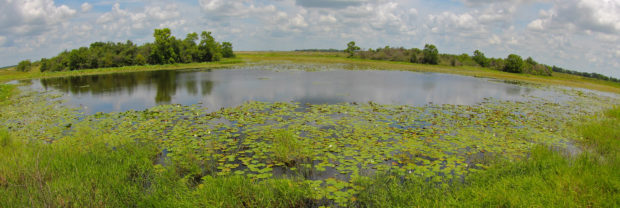We have much more to do and your continued support is needed now more than ever.
One Year After Hurricane Harvey, Are We Ready for Future Storms?

It’s been one year since Hurricane Harvey struck Texas, lashing the coast and dumping record-breaking amounts of rain over Houston and surrounding communities. The resulting floodwaters damaged over 204,000 residences in Harris County and resulted in chemical spills that polluted the air, land, and water.
The storm also took a toll on wildlife and habitats across the coast—and may prove to be the last straw for the critically endangered Attwater’s prairie chicken. After years of floods and droughts, only a dozen of these native grouse—with their unique mating dance—remain in the wild.
Are more “Harveys” on the way?

Rising air and sea temperatures associated with climate change could make storms like Hurricane Harvey far more common in the future. According to the new U.S. climate assessment report, tropical storms and hurricanes are expected to behave more like Hurricane Harvey in a few key ways:
- rapid intensification of storms could become more common,
- storms will be more likely to produce greater amounts of rainfall, and
- storms will be more likely to move more slowly, meaning potentially more rain in one area.
Sea level rise will further increase the frequency and extent of flooding and damage from coastal storms.
Planning for a Resilient Future
Coastal cities across the country should be preparing for a future where more intense storms pose two-fold risks—increased storm surge and previously-unimagined amounts of rainfall.
Protect natural storm buffers: Coastal cities like Houston should start by protecting the natural sponges and buffer habitats they currently have. For example, the vast expanse of native prairie lands in West Houston soak up excess rainfall, but this region faces intense development pressure. The coastal wetlands that flank Houston to the south provide significant storm surge protections—and fuel the commercial and recreational fishing economies. These are examples of irreplaceable natural storm defenses that, once degraded and lost, cannot be replaced.

Create or restore natural infrastructure: One recent study found that the restoration of marshes and oyster reefs were among the most cost-effective solutions for flood risk reduction on the Gulf Coast. Natural infrastructure is often more adaptive to storms and changing conditions because it can self-repair after storms and may be able to adapt to rising seas. This can translate into lower maintenance and repair costs over time.
For example, many coastal communities are building living shorelines that use breakwaters—often made up of oyster reefs—to reduce storm surge and prevent erosion. The calmer waters behind the breakwaters can provide excellent habitat for wetlands and seagrass beds. Living shorelines have immediate benefits, like improved water quality and better habitat for fish and birds, while providing meaningful protection from storm surge.

Consider the consequences: Many coastal cities like Houston face intense pressure to armor their coasts with levees and seawalls and create large concrete and steel drainage systems to move floodwaters out of urban areas. But these traditional approaches alone may not yield the same results we’ve seen in the past. Hardened infrastructure like bulkheads and seawalls can accelerate coastal erosion, putting other areas at risk. Also these types of hardened approaches are expensive to maintain and repair and eventually need to be augmented or replaced to keep up with rising water levels.
Create Adaptive Strategies: We know storms will not look the same in the future as they have in the past, and neither will our coasts. A business-as-usual path forward may limit the options we have to adapt to risk in the future. But we can act despite uncertainty. Robust yet flexible risk reduction strategies that can be adjusted along the way will increase the effectiveness and longevity of our investments and maximize protection for people and wildlife.
Hopeful Signs in Houston?

In Houston, new collaborations are helping to push these types of ideas forward. The Greater Houston Flood Mitigation Consortium is disseminating scientifically-informed data about comprehensive flood mitigation opportunities in the region, including natural infrastructure. A collaboration of local environmental, business, and governmental entities have put together the Gulf-Houston Regional Conservation Plan to achieve 24% nature-based infrastructure by 2040. By relying more on natural infrastructure to protect our cities and coasts, we can simultaneously ensure the habitat of vulnerable species, like the Attwater’s prairie chicken, is better protected from severe flooding and subsequent contamination of its land and water.
Most importantly, the Harris County Flood Control District is holding a $2.5 billion flood bond election on Saturday, August 25—the one-year anniversary of the day Harvey made landfall. If it passes, it will be the largest local investment in flood management ever in the county.
Live in Harris County? Click here to learn about the bond and where to vote.
VOTE
The National Wildlife Federation is working across the Gulf of Mexico—and throughout the country—to make our coasts more resilient to hurricanes, storms and droughts. Please support our work!





















